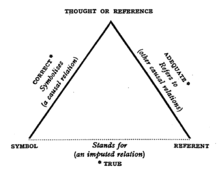I. A. Richards
Ivor Armstrong Richards CH (26 February 1893[1] – 7 September 1979[1]), known as I. A. Richards, was an English educator, literary critic, poet, and rhetorician. His work contributed to the foundations of the New Criticism, a formalist movement in literary theory which emphasized the close reading of a literary text, especially poetry, in an effort to discover how a work of literature functions as a self-contained and self-referential æsthetic object.
Richards' intellectual contributions to the establishment of the literary methodology of the New Criticism are presented in the books The Meaning of Meaning: A Study of the Influence of Language upon Thought and of the Science of Symbolism (1923), by C. K. Ogden and I. A. Richards, Principles of Literary Criticism (1924), Practical Criticism (1929), and The Philosophy of Rhetoric (1936).
Richards was born in Sandbach. He was educated at Clifton College[2] and Magdalene College, Cambridge, where his intellectual talents were developed by the scholar Charles Hicksonn 'Cabby' Spence.[3] He began his career without formal training in literature; he studied philosophy (the "moral sciences") at Cambridge University, from which derived his assertions that, in the 20th century, literary study cannot and should not be undertaken as a specialisation, in and of itself, but studied alongside a cognate field, such as philosophy, psychology or rhetoric. His early teaching appointments were as adjunct faculty: at Cambridge University, Magdalene College would not pay a salary for Richards to teach the new, and untested, academic field of English literature. Instead, like an old-style instructor, he collected weekly tuition directly from the students, as they entered the classroom.
In the 1929–30 biennium, as a visiting professor, Richards taught Basic English and Poetry at Tsinghua University, Beijing.[4][5] In the 1936–38 triennium, Richards was the director of the Orthological Institute of China.[4] He died in Cambridge.
The life and intellectual influence of I. A. Richards approximately corresponds to his intellectual interests; many endeavours were in collaboration with the linguist, philosopher, and writer Charles Kay Ogden (C. K. Ogden), notably in four books:
I. Foundations of Aesthetics (1922) presents the principles of aesthetic reception, the bases of the literary theory of “harmony”; aesthetic understanding derives from the balance of competing psychological impulses. The structure of the Foundations of Aesthetics—a survey of the competing definitions of the term æsthetic—prefigures the multiple-definitions work in the books Basic Rules of Reason (1933), Mencius on the Mind: Experiments in Multiple Definition (1932), and Coleridge on Imagination (1934)

